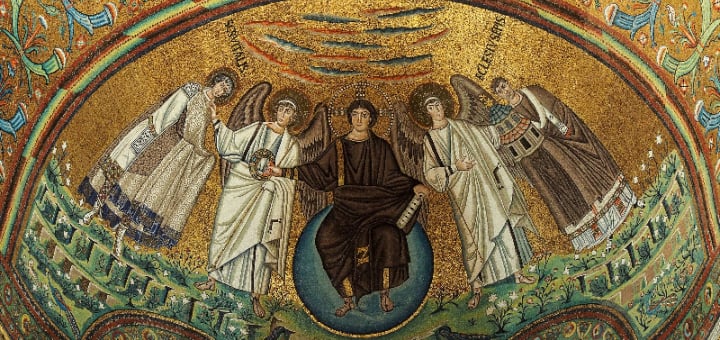
Lent is a time of reflection before Easter and the preparation before Christ’s sacrifice on Good Friday. Why, then, did the color purple come to represent this liturgical season?
The answer comes from Ancient Rome, when early Christians were persecuted and forced to practice their religion in secret. Despite the risk of death, they celebrated by creating beautiful underground tombs (catacombs) decorated with Christian iconography.
 Early Christians used symbols in their art to hide their religion from the authorities, and are still in use today: The Trinity, the Lamb of God and the Christian fish. By far the most powerful symbol used in their art was the color purple.
Using purple in their religious artwork was incredibly dangerous because the color belonged to the Roman Emperor. It was the color of royalty and only Caesar was allowed to wear it. In a dangerous act of rebellion, Christians dressed Jesus in the same clothes as Caesar – proudly depicting him as their true King.
Early Christians used symbols in their art to hide their religion from the authorities, and are still in use today: The Trinity, the Lamb of God and the Christian fish. By far the most powerful symbol used in their art was the color purple.
Using purple in their religious artwork was incredibly dangerous because the color belonged to the Roman Emperor. It was the color of royalty and only Caesar was allowed to wear it. In a dangerous act of rebellion, Christians dressed Jesus in the same clothes as Caesar – proudly depicting him as their true King.
 By © José Luiz Bernardes Ribeiro, CC BY-SA 4.0, Wikimedia Commons[/caption]
By © José Luiz Bernardes Ribeiro, CC BY-SA 4.0, Wikimedia Commons[/caption]
 By Petar Milošević - Own work, CC BY-SA 4.0, Wikimedia Commons[/caption]
These two examples of Christ come from an early Christian church in Ravenna, Italy, built in 547 A.D. In one scene Jesus is a gentle shepherd, while in the other He rules from Heaven. Both show Jesus wearing a Roman toga of imperial purple and gold. Time has faded the colors, and so Jesus’ robes might not look purple in our eyes, but early Christians would have been overwhelmed by the sight.
The use of royal purple in sacred art continued into the Renaissance, where many artists painted scenes from the Passion. There is, however, a lot of sacred art that has Jesus wearing scarlet (red) robes. This is because the purple dye was so expensive only the wealthy (or royalty) could afford to buy it. Instead, artists would use red dye as a cheap alternative knowing that viewers would still understand the meaning.
By Petar Milošević - Own work, CC BY-SA 4.0, Wikimedia Commons[/caption]
These two examples of Christ come from an early Christian church in Ravenna, Italy, built in 547 A.D. In one scene Jesus is a gentle shepherd, while in the other He rules from Heaven. Both show Jesus wearing a Roman toga of imperial purple and gold. Time has faded the colors, and so Jesus’ robes might not look purple in our eyes, but early Christians would have been overwhelmed by the sight.
The use of royal purple in sacred art continued into the Renaissance, where many artists painted scenes from the Passion. There is, however, a lot of sacred art that has Jesus wearing scarlet (red) robes. This is because the purple dye was so expensive only the wealthy (or royalty) could afford to buy it. Instead, artists would use red dye as a cheap alternative knowing that viewers would still understand the meaning.
 By Quentin Matsys - CGFA, Public Domain, Wikimedia Commons[/caption]
This painting by Quentin Massys (1520) shows Jesus before the angry crowd. The title, Ecce Homo, is a Latin phrase meaning ‘Behold the Man” which is what Pontius Pilate announced as he brought Jesus out to be judged. Hands tied and wearing the crown of thorns, Jesus is presented to us with nothing but a purple cloak on his back. Jesus’ calm acceptance of His fate is a sharp contrast to the angry expressions of the crowd behind Him.
Christ's sacrifice on the cross not only proved His love, by dying for our sake, but also proved His divinity, by rising from the dead. This is why the color purple became associated with Lent. Roman soldiers mocked Christ by dressing him in a royal outfit, but the truth is far greater. The color of Lent is purple because Jesus is the King of Heaven and Earth.
The use of royal purple in the Lenten season is a reminder of our faithfulness to the true King of Kings.
By Quentin Matsys - CGFA, Public Domain, Wikimedia Commons[/caption]
This painting by Quentin Massys (1520) shows Jesus before the angry crowd. The title, Ecce Homo, is a Latin phrase meaning ‘Behold the Man” which is what Pontius Pilate announced as he brought Jesus out to be judged. Hands tied and wearing the crown of thorns, Jesus is presented to us with nothing but a purple cloak on his back. Jesus’ calm acceptance of His fate is a sharp contrast to the angry expressions of the crowd behind Him.
Christ's sacrifice on the cross not only proved His love, by dying for our sake, but also proved His divinity, by rising from the dead. This is why the color purple became associated with Lent. Roman soldiers mocked Christ by dressing him in a royal outfit, but the truth is far greater. The color of Lent is purple because Jesus is the King of Heaven and Earth.
The use of royal purple in the Lenten season is a reminder of our faithfulness to the true King of Kings.
Copyright 2020 Caleigh McCutcheon
 Early Christians used symbols in their art to hide their religion from the authorities, and are still in use today: The Trinity, the Lamb of God and the Christian fish. By far the most powerful symbol used in their art was the color purple.
Using purple in their religious artwork was incredibly dangerous because the color belonged to the Roman Emperor. It was the color of royalty and only Caesar was allowed to wear it. In a dangerous act of rebellion, Christians dressed Jesus in the same clothes as Caesar – proudly depicting him as their true King.
Early Christians used symbols in their art to hide their religion from the authorities, and are still in use today: The Trinity, the Lamb of God and the Christian fish. By far the most powerful symbol used in their art was the color purple.
Using purple in their religious artwork was incredibly dangerous because the color belonged to the Roman Emperor. It was the color of royalty and only Caesar was allowed to wear it. In a dangerous act of rebellion, Christians dressed Jesus in the same clothes as Caesar – proudly depicting him as their true King.
 By © José Luiz Bernardes Ribeiro, CC BY-SA 4.0, Wikimedia Commons[/caption]
By © José Luiz Bernardes Ribeiro, CC BY-SA 4.0, Wikimedia Commons[/caption]
 By Petar Milošević - Own work, CC BY-SA 4.0, Wikimedia Commons[/caption]
These two examples of Christ come from an early Christian church in Ravenna, Italy, built in 547 A.D. In one scene Jesus is a gentle shepherd, while in the other He rules from Heaven. Both show Jesus wearing a Roman toga of imperial purple and gold. Time has faded the colors, and so Jesus’ robes might not look purple in our eyes, but early Christians would have been overwhelmed by the sight.
The use of royal purple in sacred art continued into the Renaissance, where many artists painted scenes from the Passion. There is, however, a lot of sacred art that has Jesus wearing scarlet (red) robes. This is because the purple dye was so expensive only the wealthy (or royalty) could afford to buy it. Instead, artists would use red dye as a cheap alternative knowing that viewers would still understand the meaning.
By Petar Milošević - Own work, CC BY-SA 4.0, Wikimedia Commons[/caption]
These two examples of Christ come from an early Christian church in Ravenna, Italy, built in 547 A.D. In one scene Jesus is a gentle shepherd, while in the other He rules from Heaven. Both show Jesus wearing a Roman toga of imperial purple and gold. Time has faded the colors, and so Jesus’ robes might not look purple in our eyes, but early Christians would have been overwhelmed by the sight.
The use of royal purple in sacred art continued into the Renaissance, where many artists painted scenes from the Passion. There is, however, a lot of sacred art that has Jesus wearing scarlet (red) robes. This is because the purple dye was so expensive only the wealthy (or royalty) could afford to buy it. Instead, artists would use red dye as a cheap alternative knowing that viewers would still understand the meaning.
 By Quentin Matsys - CGFA, Public Domain, Wikimedia Commons[/caption]
This painting by Quentin Massys (1520) shows Jesus before the angry crowd. The title, Ecce Homo, is a Latin phrase meaning ‘Behold the Man” which is what Pontius Pilate announced as he brought Jesus out to be judged. Hands tied and wearing the crown of thorns, Jesus is presented to us with nothing but a purple cloak on his back. Jesus’ calm acceptance of His fate is a sharp contrast to the angry expressions of the crowd behind Him.
Christ's sacrifice on the cross not only proved His love, by dying for our sake, but also proved His divinity, by rising from the dead. This is why the color purple became associated with Lent. Roman soldiers mocked Christ by dressing him in a royal outfit, but the truth is far greater. The color of Lent is purple because Jesus is the King of Heaven and Earth.
The use of royal purple in the Lenten season is a reminder of our faithfulness to the true King of Kings.
By Quentin Matsys - CGFA, Public Domain, Wikimedia Commons[/caption]
This painting by Quentin Massys (1520) shows Jesus before the angry crowd. The title, Ecce Homo, is a Latin phrase meaning ‘Behold the Man” which is what Pontius Pilate announced as he brought Jesus out to be judged. Hands tied and wearing the crown of thorns, Jesus is presented to us with nothing but a purple cloak on his back. Jesus’ calm acceptance of His fate is a sharp contrast to the angry expressions of the crowd behind Him.
Christ's sacrifice on the cross not only proved His love, by dying for our sake, but also proved His divinity, by rising from the dead. This is why the color purple became associated with Lent. Roman soldiers mocked Christ by dressing him in a royal outfit, but the truth is far greater. The color of Lent is purple because Jesus is the King of Heaven and Earth.
The use of royal purple in the Lenten season is a reminder of our faithfulness to the true King of Kings.
Copyright 2020 Caleigh McCutcheon
About the Author

Caleigh McCutcheon
Caleigh McCutcheon is the curator at the Museum of Family Prayer in North Easton, MA. She has a BA in English from Stonehill College and a MA in Art History from Glasgow University. Her Master’s thesis focused on the complexity and lasting power of the Pieta image in Christian art. She considers art to be one of the most powerful forms of prayer.


.png?width=1806&height=731&name=CatholicMom_hcfm_logo1_pos_871c_2728c%20(002).png)
Comments